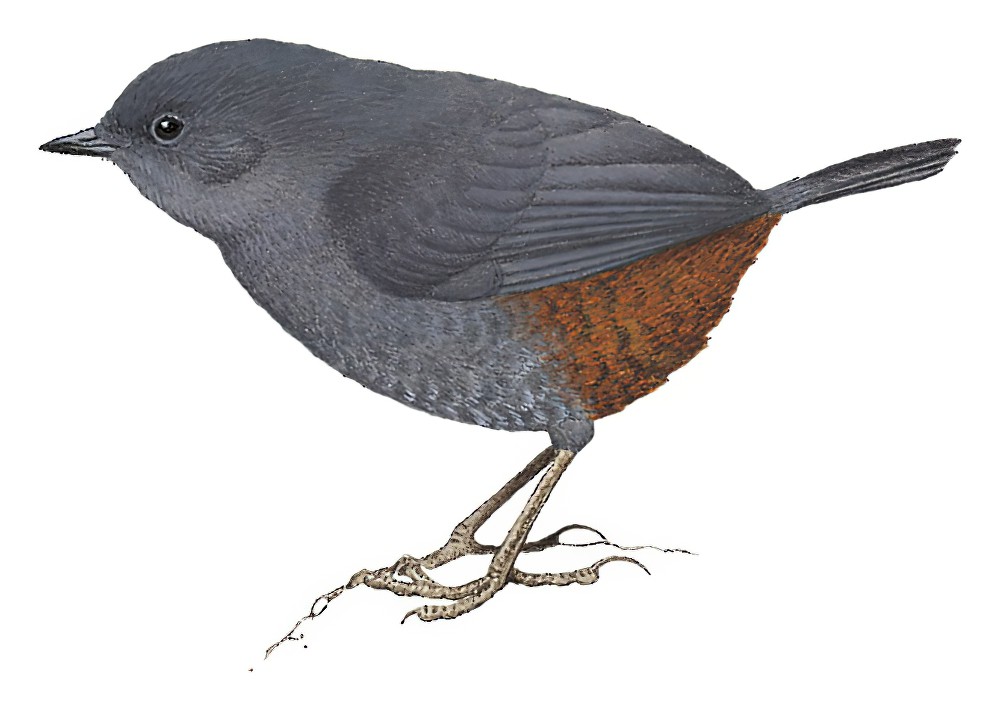Trilling Tapaculo / Scytalopus parvirostris

Trilling Tapaculo
SCI Name:
Protonym: Scytalopus unicolor parvirostris Am.Mus.Novit. no.1044 p.3
Taxonomy: Passeriformes / Rhinocryptidae / Scytalopus
Taxonomy Code: tritap1
Type Locality: Rio Aceramarca, 10,800 feet, Bolivia.
Author: Zimmer, JT
Publish Year: 1939
IUCN Status: Least Concern
DEFINITIONS
SCYTALOPUS
(Rhinocryptidae; Ϯ Dusky Tapaculo S. fuscus) Gr. σκυταλη skutalē or σκυταλον skutalon stick, cudgel; πους pous, ποδος podos foot; "Mr. Gould also proposed a new genus in the group of Wrens, under the name of Scytalopus, and which he characterized as follows: Genus SCYTALOPUS. Rostrum capite brevius, compressum, obtusum leviter recurvum. Nares basales, membrana tectæ. Alæ concavæ, breves, rotundatæ, remige prima abbreviata, tertia, quarta, quinta et sexta æqualibus. Cauda brevis, rotundata, (pennis externis brevissimis,) laxa. Tarsi elongati, atque robusti, antrorsum scutellis tecti; posterius fasciis angustis cincti, squamis serpentum abdominalibus, haud dissimilibus; halluce elongato et robusto; ungue elongato; digitum anteriorum, medio elongato et gracili. SCYTALOPUS FUSCUS. ... Hab. in Fretu Magellanico, Chili, &c. Hoc genus ad illud in quo Troglodytes veræ amplectuntur maximam affinitatem demonstrat. SCYTALOPUS ALBOGULARIS. ... Hab. in Brasilia." (Gould 1837); "The general contour of form is that of Troglodytes ... the tail is even shorter than in that genus, and consists of decomposed feathers, the whole has a rugged and disunited appearance; and lastly, the tarsi have their posterior aspect regularly banded with narrow scales, instead of having one or two continuous laminæ on that part. ... Tarsi long and stout, the forepart covered with large scutellæ; the hind part bound round with narrow scales, like the abdominal scales of snakes; hind toe long and rather stout, claw long; middle toe long and slender, and with the other two fore toes furnished with fine nails." (Gould 1851); "Scytalopus Gould, Proc. Zool. Soc. London, pt. 4, 1836 (1837), p. 89. Type, by subsequent designation, Sylvia Magellanicus (Lath.) = Motacilla magellanica Gmelin (G. R. Gray, List Gen. Bds., 1840, p. 19)." (Peters 1951, VII, 283) (see Myornis).
Var. Scytolopus.
Synon. Agathopus, Sylviaxis.
parvirostris
L. parvus small; -rostris -billed < rostrum beak.
● ex “Pato pico pequeño” of de Azara 1802-1805, no. 432 (syn. Anas sibilatrix).
● "54. Tetrao, L. 141. urogallus, L. (major, Br. crassirostris, Brehm. hybridus, L. cum Lyr. tetrice. medius, Leisl. intermedius, Langsd. pseudourogallus, Brehm. maculatus, Brehm. urogalloides, Nilss.) 142. parvirostris, Bp. (urogalloides, Middend.)" (Bonaparte 1856). According to Mlíkovsky 2012, "the Black-billed Capercaillie should be called Tetrao urogalloides Middendorff, 1853, not Tetrao parvirostris Bonaparte, 1856." (syn. Tetrao urogalloides).
UPPERCASE: current genus
Uppercase first letter: generic synonym
● and ● See: generic homonyms
lowercase: species and subspecies
●: early names, variants, mispellings
‡: extinct
†: type species
Gr.: ancient Greek
L.: Latin
<: derived from
syn: synonym of
/: separates historical and modern geographic names
ex: based on
TL: type locality
OD: original diagnosis (genus) or original description (species)












